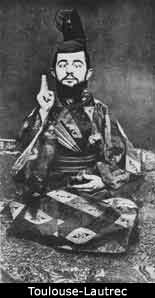"Crowning the Montmartre-based world of commercial entertainment was Joseph Oller and Charles Zidler's landmark music hall, the Moulin Rouge..."
When the Moulin Rouge opened at the northern tip of Montmartre on the 6th of October 1889, all Paris turned out. All society alike mobbed the 'Palace of Women' before the paint was dry on its interior. The Moulin Rouge's decor, by Montmartre painter Adolphe Willette, its exotic color and themes became an overnight legend.
Besides the dance hall (complete with galleries to watch the dance floor and an orchestra mounted above the stage), there was a garden with another stage, tables, cavorting monkeys and unstockinged prostitutes riding donkeys. Also in the garden, a giant elephant had an Arabian-themed club inside its body. Male customers entered through the elephant's leg where a staircase opened to belly dancing performances, an orchestra and an opium den. European royalty, ambassadors, politicians, industrialists, and magistrates slummed it with celebrity courtesans, can-can girls, and workers. The local Bohemians and the cocottes, prostitutes, pimps, madams, and thieves were also out in force. Within the Moulin's velvet draped walls, the aromas of women's scent, face powder, tobacco, and beer mingled as much as the audience. In a class of their own were the courtesans, a social wonder that all but died out with the end of the Belle Époque and the beginning of World War I. Though coming from the same working class as the prostitutes, the more celebrated courtesans were distinguished by the type of the relationships they formed (with, near exclusively, the elite of Europe). Like today's film stars and supermodels, they were also observed by press and public. But if the Moulin Rouge quickly established its reputation as the most exotic sex market in Paris, it also represented a kind of cultural and social revolution. Think of it as a can-can-besotted version of Steve Rubell's disco-crazed Studio 54 crossed with Bangkok's sex market meets Mardi Gras' carnival.
(Much of the above information was taken from the Club Moulin Rouges Behind the Story section.)
Many of the characters featured in Baz Luhrman's Moulin Rouge were real people back in the days of the Belle Époque: Le Petomane (a performer), Mome Fromage (one of Zidlers Four Whores), and the infamous Toulouse-Lautrec were celebrated in the Moulin Rouge of the 1890s.



